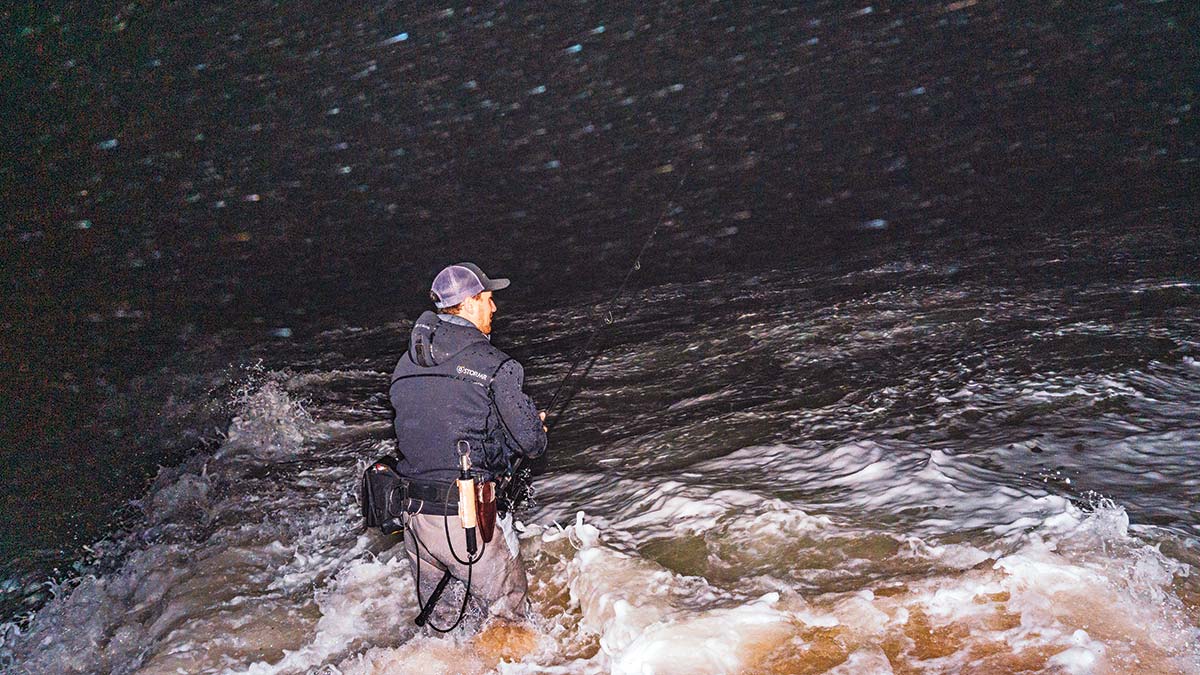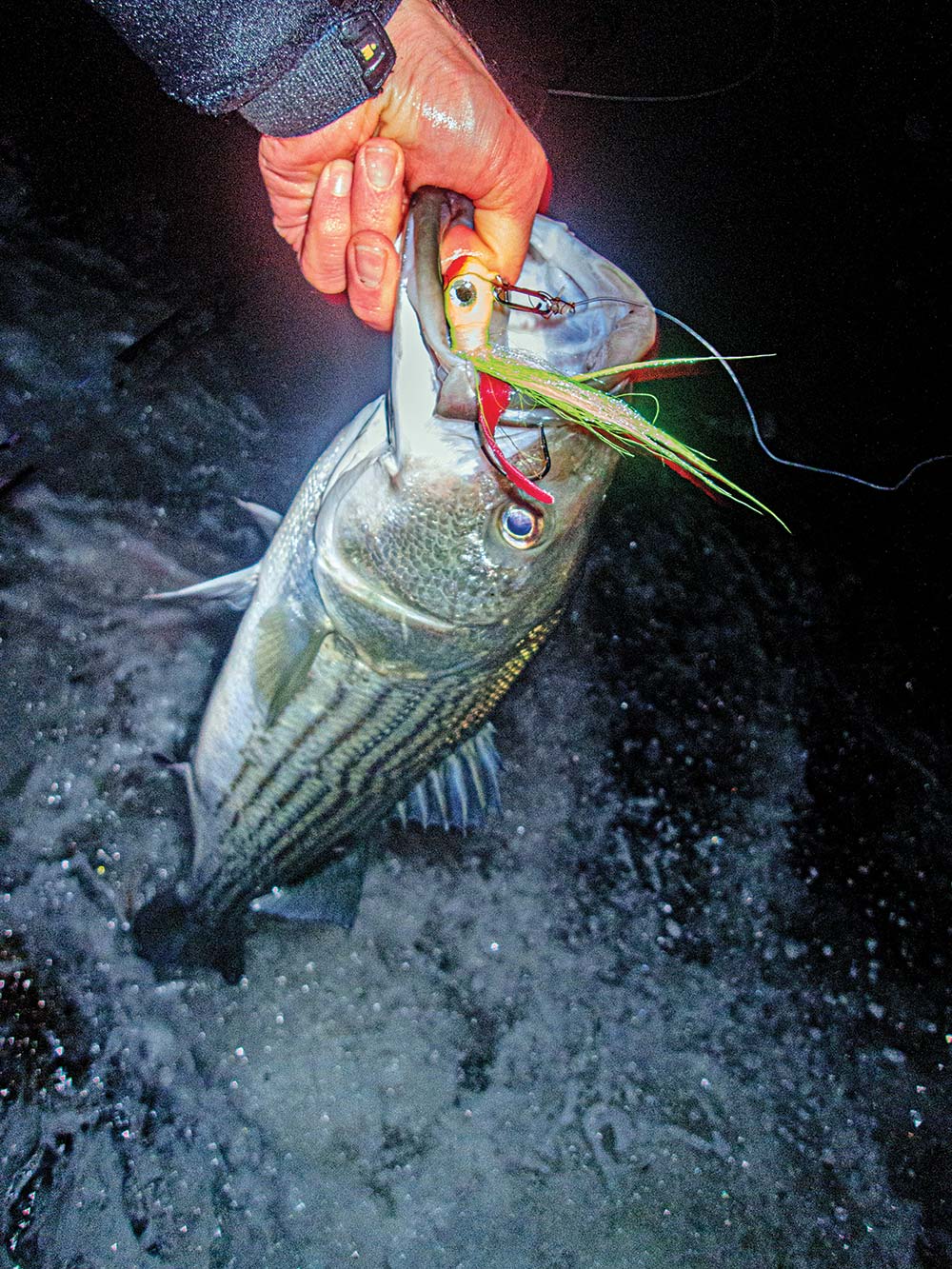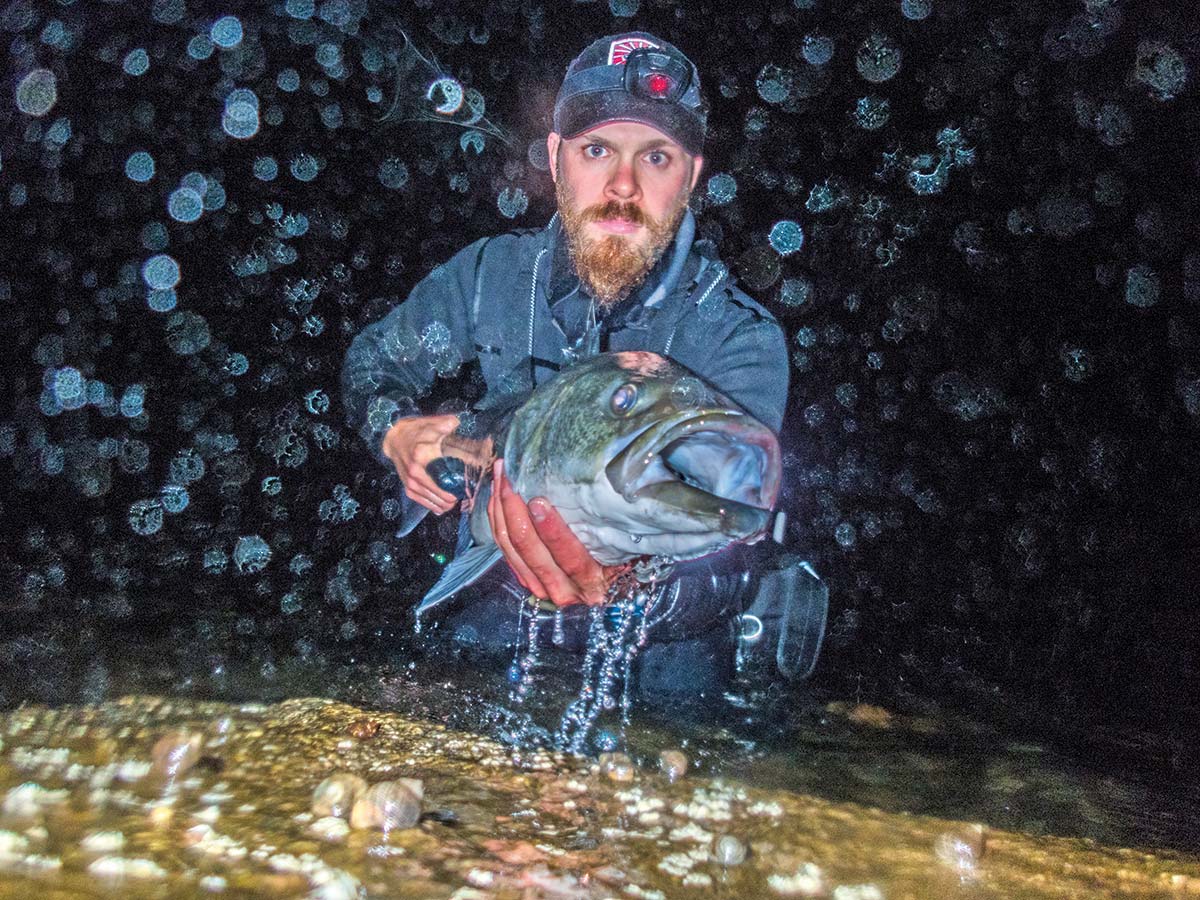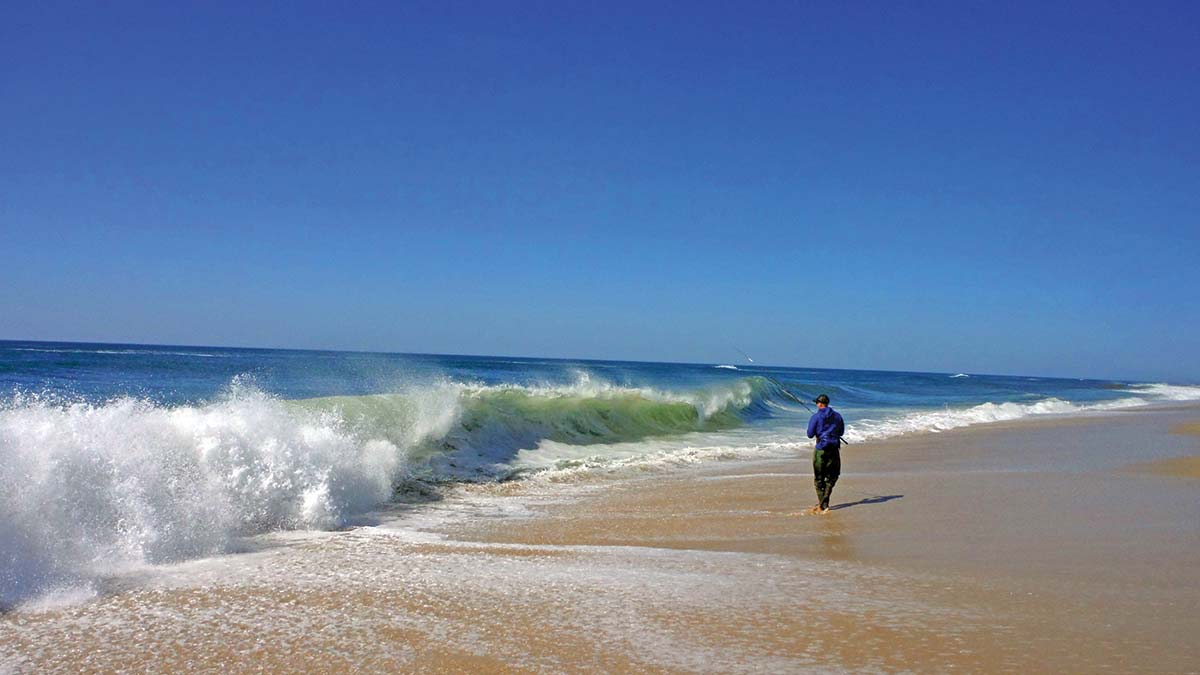
When the wind is raging out of the northeast in September and October, he is worthless all day and his mind turns to mush.
There is something about fishing big water conditions in the surf, particularly in the fall, that I find intoxicating. It’s an enthralling combination of experiencing the almost unfathomable power of the raging sea, the challenge of working a plug in savage conditions, and the prospect of catching a trophy-sized fish. When I prepare for a night fishing in a storm, I am nervous. My nerves get raw, and I feel jumpy and anxious all day, often having a sensation of “vibrating” or “being on edge.” When conditions line up just right, I have to take the day off from work simply because I am not able to sit at a desk for even a few minutes, let alone multiple hours. I simply can’t focus! Surf guide Bill Wetzel of Long Island mirrors my own feelings the most clearly: he said to me at a show years ago (and has been recorded and quoted often) that when the wind is raging out of the northeast in September and October, he is worthless all day and his mind turns to mush in anticipation. That is precisely how I feel about it, too.
However, I also fully understand how intimidating and difficult it can be to fish these conditions for many anglers. I personally have had tides where I drove over an hour to the coast, only to be so intimidated I decided to stand so far back from the water I couldn’t even reach the first wave; ultimately I left after only a feeble few casts. But this level of caution is advisable; these storms can be dangerous and lives have been lost under by anglers who took risks. Therefore, I urge you to be smart and never, ever enter into a situation that could put you in peril. Better to not fish today, than to never fish again.
That being said, I have worked hard to learn, implement, and modify techniques to fish these big conditions, because I’m so devoted to them. Here are a few of those that I believe are most important.
Tried And True Tactics

When fishing storms I would suggest not going alone. While I do it, having back up (and perhaps a voice of reason) is smart during situations with big winds and waves. Next, if you have never done this before, or want to get better at it, try fishing a moderate event during dawn or sunset. Don’t try going out in the middle of the night and fishing in 50-plus-knot winds the first few times you are trying to figure out how to tackle a storm. Instead, I suggest picking a couple of days where the wind is less than 30 knots. To this point, another way to get your feet wet (pun intended) is to try fishing the onset of a storm, well before it makes full landfall. This is generally when the water is the cleanest, and the winds are still building. Therefore, you can ease into it and see where your skill or abilities break down; in other words, where your limit is. Also, make sure your gear is top-notch for your budget. These conditions will find every chink in your armor and variables like a leaky surf top, weak line, poorly-maintained reel, dull hooks, and other oversights will punish you with a lot of frustration, discomfort, and heart break. Finally, I would suggest the first few times you go out, don’t expect to catch a lot of fish. Instead, focus on becoming comfortable and investing in your skills for the future. I had to work on my own ability for many years before I became competent fishing big water.
Further, I suggest trying to fish sand beaches while learning to tackle big water conditions. They are more forgiving (vs. boulder fields, ledge areas, jetties, etc.) as you can’t get hung up on any hard structure, the fish are often close to shore, and landing and releasing them is easier. They are also safer, and if conditions get too crazy I will abandon my beloved boulder fields and instead ply the sand for my own safety. Sand beaches can also be very productive during the fall storms, and there is something really exciting, almost romantic, about catching stripers from a sand beach in a big swell. There is a lot of history there!
Also, the number of plugs you need to learn is generally lower on the sand beaches. Often when conditions get crazy, fish are on the feed and get very aggressive, therefore you do not have to have 30 different plugs in your bag. On sand beaches generally you just want a few different profiles that can reach the fish. This really applies to all areas you might fish in a storm, but the difference on sand beaches is that you have a huge margin of error to either let it drag on the bottom or get washed into shore without hanging up and losing the plug. Further, since you’ll generally be fishing shallower water, you don’t have to try and dial in presentation depth to the same degree as in other structure like boulder fields, inshore rips, or drop-offs. I’ll talk about plugs later in the article, but for sand beach storm fishing, a bag full of different weights of the classic bucktail with a trailer (I still prefer Uncle Josh Pork Rind) is really all you need to get started.
Wetsuit Or Bust
Last month I wrote about how wetsuits can be for so much more than swimming to distant rocks. Here again is a situation in which I am adamant a wetsuit will allow you to catch more fish more comfortably and safely. When the water is big I either fish in my wetsuit, or I don’t fish at all, particularly at night. Even on sand beaches, once the water reaches a certain wave height, I will be in my neoprene. The reasons for this are simple. Essentially, a wetsuit makes it safer for you to be knocked over or knocked down. If you are knocked over and water enters your waders, it can be very difficult to stand back up again. This can result in being rolled in the surf or pulled out into deeper water; one rogue swell is all it takes. Therefore, while wearing waders constant hyper vigilance is required, and I find this tiring and it ruins the experience for me. A wetsuit eliminates this issue; while I am still careful and treat the conditions with the respect they require, I can also focus more on the fishing. Therefore, I consider a wetsuit an essential piece of gear during rough water—whether on sand, rocks, a jetty, or in the boulders.
Have A Fall Back Position
I think one mistake surf anglers make when they fish big conditions is to assume that fish will be everywhere on the feed because of the ripping current and gigantic waves. This could not be further from the truth. They may shift their feeding behavior somewhat, but ultimately stripers and blues still only key in on places that hold bait and give them a feeding advantage. Therefore, I continue to focus on many of the same spots I normally fish during times when there aren’t storms. That is, I don’t like to experiment and search for fish during these weather events. Yes, walking or driving a sand beach during an autumn Nor’easter and covering serious ground can work, but I would not fish a beach I was not familiar with or had not scouted previously.
This is probably the single biggest piece of advice I can give you to make the most of these conditions: fish what you know. If you already have a good casting and fish landing (and release) position, know where the fish generally hold, know what the bait situation is, and understand the water movement, you are more likely to be able to safely and effectively make the most of a fall storm.

To this point, I only get really excited when conditions line up with parameters I already know are productive. Just because a storm is bearing down on a spot I normally fish doesn’t mean the fishing will be good, even if there are fish in the area. I still have to line up the tide, moon, and wind direction with what works at the specific spot to have any hope of catching a fish. In other words, if I fish a spot that only produces during an outgoing tide, I’m not going to go out into the storm and fish the incoming tide just because it’s pouring rain and blowing a gale. The same rule applies to wind direction. If I have a spot that never produces on a southeast wind, I’m not going to go fish it in a hurricane when the wind is blowing 40 knots out of the southeast. The only exception to this rule is the weight I give to tide height. The increased white water and current derived from a storm often compensates for the decreased water depth of a small tide. Therefore, even though a spot may never produce during a neap tide, if everything else is lining up and a storm is bearing down, I’m going to be excited to fish it hard.
As you probably would expect, not all spots are going to fish better in a storm. Many will get blown out or become very weedy, the current will get overwhelmed by waves, or they will simply become too dangerous. Therefore, the first step to identifying a productive big water spot is to scout and fish it during calm conditions. It’s amazing how much a spot can change under a heavy swell, and it can look almost unrecognizable compared to calm conditions. More than that, it can be hard to figure out if your lure is getting into the places that the fish hold if you do not know it intimately. Therefore, learn your rough water spots inside and out during calm conditions. Know where the structure is, and how the water interacts with it, on both tides (flood and ebb) and in all wind directions. Once you’re comfortable with this, then you can start trying to access the fish under storm conditions.
Additionally, it’s important to have as many alternative plans as possible. When storm conditions hit they can be unpredictable and frustrating. The waves may be too big, or not big enough; the same goes for the wind speed and direction and water clarity (it can be clear during some storms, and dirty the next). The weather service often has a hard time predicting what is going to happen with these events, right up to the moment they make landfall. Therefore, I try to have a multi-layered back-up plan. I’ll hope that my primary spot, or spots, will work out, but if not, I’ll have a handful of backups. Then, if all of this fails, I try and insure I have a “worst case scenario” plan. This is typically a spot in the lee of the wind, in a back water estuary, or on a shoreline with the wind at my back. Somewhere I know the water will be clean and I can actually cast to productive water, even if it just has schoolies in it. In other words, a spot that at least makes the drive to the shore worth it. And, as an aside, these back-up spots can also be very productive during storms, but that is a topic for an entirely different article.
Plug Essentials
It’s very important to have a deep understanding of the plugs you’re going to use and how each one works in these (sometimes harrowing) surf conditions. This is no time for experimentation—not for me anyways. I fall back on a small selection of plugs that make up a variety of profiles which can also be casted into a 50-knot wind. I will have tested them extensively prior to ever going out into a storm, understanding how fast they sink, their action, and how they respond to roaring white water and blistering currents.
While the bucktail is the all-time champion of big water conditions, it is far from the only plug I use. In fact, I often only fall back on a bucktail as a last resort. However, the reasons for this go beyond any real logic (I simply like fishing plugs), and I concede that in the kind of weather event I’m discussing here, you often won’t need anything but bucktails. Bucktails have an unrivaled ability to both be casted in huge winds and fished in the roughest waters; they are a must-have during storms. Typically, if there are fish in the area they are aggressive and ready to jump on anything that looks edible, and the bucktail is a great mimic of a huge variety of baits. With the intensification of wind and waves, they also have less time to decide whether to eat your offering, or examine it, and therefore are a lot less picky. A bucktail can get out there, and that’s often all you will need if you’ve done all the other leg work involved with finding a good storm fishing spot. I give the nod to affordable bucktails like Andrus and Blue Frog, but there’s so many amazing makers out there it’s hard to pick a favorite.

If you’re a day time fisherman, the same rules are essentially true of tins (like AVA jigs and Acme Kastmasters). They cast great, and can be used in shockingly large waves. Yet, I’m still likely to throw a bucktail over a tin during the day; it’s simply my preference, and I have had great success doing so. The only other daytime plug I specifically bring up is the Super Strike Little Neck Popper. Poppers in general (pencil, polaris, and atom styles) are actually a good choice in storms because they cast very well; however I default to the same yellow-over-white 2 3/8-ounce Little Neck virtually every time. You don’t necessarily need to worry about popping it either- often just swimming it through the waves is enough.
However, as a primarily night time fisherman, my alternate essentials to the bucktail are needlefish (needles) and bottle plugs (bottles). However, that is like saying the best off-road vehicles are trucks; it’s very general and not totally accurate. There are so many options for these plugs, and not all are created equal; indeed many needles and bottles are really crummy at fishing in big waves and heavy currents. This is often intentional as they are designed for shallow water or very slow retrieves. I would suggest sticking with Super Strike needles (both heavy and standard) and bottle plugs if you’re just starting out, or trying to get better at this kind of fishing. The heavy needles are very similar to bucktails in their ability to handle heavy waves and current, and they cast farther than a similarly weighted bucktail. The bottle plugs can handle all but the very biggest of conditions and put out a huge amount of vibration which can be important in drawing strikes. I encourage you to try taking the hook off the rear of the plug to get every inch out of their casting distance, too. You can also load them to make them heavier (or load the standard needles to have something in between) but I rarely find this is necessary for where I fish.
The other plugs I have in my bag during storms are Sebile Stick Shadds, Northbar Bottle Darters, and Shimano Colt Snipers. The Stick Shadds have become as important to me as needlefish as the heaviest models cast almost as well as bucktails and are a much larger profile which can entice big fish. I will carry the 155 size in both sinking and fast sinking. Northbar Bottle Darters come in two sizes now and I actually prefer the smaller size. It casts very well, and will out cast the larger size even when unloaded as the smaller and more aerodynamic shape cuts through the wind better. Loaded with water, they cast like they’re shot out of a cannon. Finally, while very heavily loaded Red Fins and Bomber 16a and 17a swimming plugs can reach the fish, they don’t swim well when heavily loaded. The only stock swimmers you even have a chance of getting into the white water are Colt Snipers, the largest sized (6 ¾”) Daiwa SP minnow, and the large Yo-Zuri Mag Darter. However those last two are generally not going to work in these conditions. Yet, the 170mm sized Colt Sniper is, in my experience, the best casting swimming plug ever created and can dig into big waves surprisingly well. While pricey for a plastic swimmer, it’s the only minnow plug I’ve ever had success with in 40-knot-or-greater winds.



